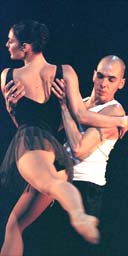
The inspiration behind Misty Frontier, Javier de Frutos's experimental collaboration with the Royal Ballet, is a chance meeting in 1945 between choreographer George Balanchine and the playwright Tennessee Williams. De Frutos is a passionate student of Williams's writing, and imagining the social chemistry between Williams and Balanchine (the defining classicist of 20th-century ballet) couldn't be a more apt starting place for his own first encounter with the Royal.
Not that anyone in this piece is concerned with what was said or done on that occasion. Rather, as its title suggests, Misty Frontier portrays an abstract convergence of opposing styles and personalities. The central material is a string of crisp numbers for the Royal's dancers that De Frutos has choreographed in a deft imitation of Balanchine's style. The three couples are elegant, charming and sunny; De Frutos, prowling among them, is their black shadow, a presence subversively redolent of power teetering on the edge of vulnerability, of secret damage hidden beneath sexual flamboyance.
Sometimes De Frutos is doggedly bent on learning the other dancers' skills (part of the soundtrack is a recorded lesson on ventriloquism); he not only imitates their poses but carefully partners both men and women. He displays wonder at their prowess as well as sexual fascination with their precision-perfect bodies - but he also infects them with his own dark energies. As the piece progresses, violence crackles through some of the duets, and the dancers, male and female alike, linger erotically over certain caresses. When De Frutos dances in his own distinctively supple, insinuating style, this sense of faint corruption, of stylistic and sexual disorientation, increases.
What accumulates is a cleverly knife-edged view of the complicated appeal of ballet: an art form so pure and disciplined on one hand, and so complicit with fetishism on the other; an art that idealises and abstracts beauty while indulging in blatant physical display. (Balanchine's own choreography may have been brilliantly analytic but it was powered by a near-voyeuristic obsession with his ballerinas and their bodies.)
De Frutos could so easily have forced this piece into crude, alienating oppositions: ballet/modern, straight/gay, classical/camp, formal/sexual, dark/light. In fact, with the subtlest of theatrical and choreographic strokes, he has created a piece that is expertly entertaining on its surface and unexpectedly fascinating in its depths. It is an insider's outside view of ballet.

